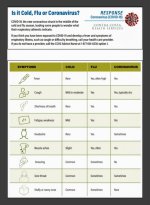Snaggy
New member
<apologies for the morbid question>
how does the assignment of cause of death work, in particular when covid-19 and co- or pre-existing conditions come into play?
clarification: are there multiple causes of death assigned?
thanks
Death Certificates are often done with surprisingly little deliberation by doctors, within pretty loose guidelines. A coroner can refuse to accept the document and ask for a revision, Doesn't happen that often.
The format is
- main cause of death and how long present
- due to, and how long present
- due to, and how long present
-Other conditions contributing to above.
-Any Surgeries performed for above and when
So for COVID, the doctor might put as primary cause
-either pneumonia or respiratory failure, present for days
-due to Novel Coronavirus, present weeks
Other conditions, Diabetes Mellitus Type 2, COPD or whatever else
Or maybe Coronavirus would be listed first
Or, maybe it would be
-Respiratory failure, due to ARDS, due to COVID
There could be a fair number of more or less correct ways.
It's important for Coronavirus to be in those top three for epidemiologic purposes.
What happens if the doctor thinks a fatal pneumonia could have been caused by Coronavirus but didn't get a test?
He should put the pneumonia as "due to Coronavirus", but not every Doc would, depending on the level of their suspicions, and that certificate would probably not be challenged either way.
CDC believes this is happening, because the deaths in the "Pneumonia and Influenza" category, not attributed to Coronavirus, is about 1-2% higher than expected.
Death Certificates can be disturbingly imprecise or even inaccurate because many thousands of doctors and coroners have their own ideas on how they should be done.



 Whether or not they do is still debatable, but the understanding on why they thought they would is there for me now.
Whether or not they do is still debatable, but the understanding on why they thought they would is there for me now.